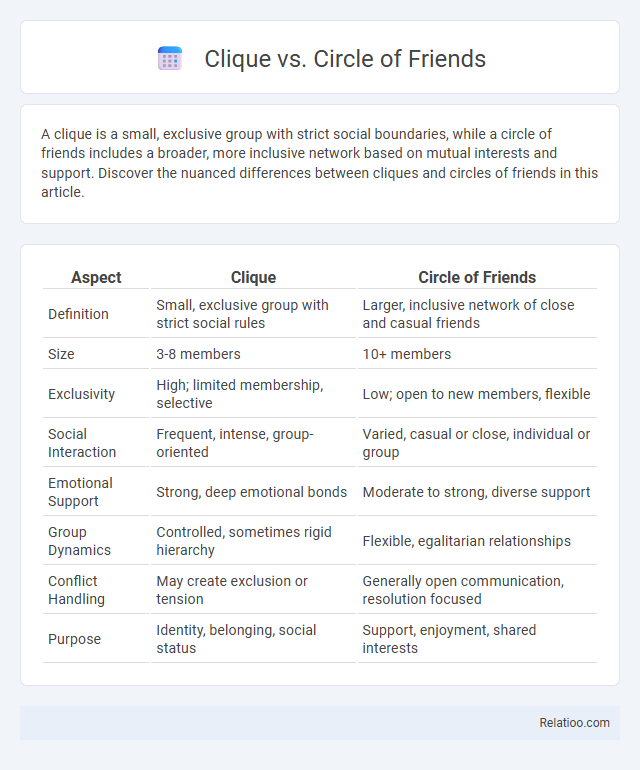A clique is a small, exclusive group with strict social boundaries, while a circle of friends includes a broader, more inclusive network based on mutual interests and support. Discover the nuanced differences between cliques and circles of friends in this article.
Table of Comparison
| Aspect | Clique | Circle of Friends |
|---|---|---|
| Definition | Small, exclusive group with strict social rules | Larger, inclusive network of close and casual friends |
| Size | 3-8 members | 10+ members |
| Exclusivity | High; limited membership, selective | Low; open to new members, flexible |
| Social Interaction | Frequent, intense, group-oriented | Varied, casual or close, individual or group |
| Emotional Support | Strong, deep emotional bonds | Moderate to strong, diverse support |
| Group Dynamics | Controlled, sometimes rigid hierarchy | Flexible, egalitarian relationships |
| Conflict Handling | May create exclusion or tension | Generally open communication, resolution focused |
| Purpose | Identity, belonging, social status | Support, enjoyment, shared interests |
Understanding Cliques and Circles of Friends
Cliques are small, exclusive groups where members share strong, often rigid bonds and common interests, while circles of friends represent broader, more inclusive social networks with flexible and diverse relationships. Understanding cliques involves recognizing their tendency to enforce conformity and social hierarchy, whereas circles of friends emphasize mutual support and varied interactions. Both structures significantly influence social dynamics, self-identity, and peer interactions during developmental stages.
Core Differences Between Cliques and Circles
Cliques are exclusive, tightly-knit groups defined by strict membership criteria, often leading to social exclusion, while circles of friends are more inclusive and flexible, fostering open interaction among members. Cliques prioritize homogeneity and social status within the group, whereas circles emphasize mutual support and shared interests without rigid boundaries. The core difference lies in cliques' controlled intimacy and exclusivity contrasted with the circles' broader, more adaptive social connections.
Social Dynamics of Cliques
Cliques exhibit rigid social dynamics characterized by exclusivity, hierarchical roles, and strong in-group loyalty, which contrasts with the more fluid and inclusive nature of circles of friends that emphasize mutual support and shared interests. Understanding these patterns reveals how cliques can influence your social interactions by promoting conformity and sometimes exclusion, while circles of friends encourage genuine connection and flexibility. The distinct social structures shape communication styles and group cohesion, highlighting the psychological need for belonging within various social settings.
Openness and Inclusivity in Circles of Friends
Circles of friends emphasize openness and inclusivity, fostering diverse, supportive social networks where members actively welcome new individuals. In contrast, cliques maintain exclusivity by enforcing strict boundaries and limiting interaction to a select group, often leading to social exclusion. The fundamental difference lies in the flexibility of circles to adapt and grow, promoting social cohesion and broader community engagement.
Emotional Impact on Members
Circles of friends foster inclusivity and emotional security, promoting trust and deeper connections among members. Cliques often create exclusivity, which can lead to feelings of isolation and lower self-esteem for those outside the group. Your emotional well-being is more positively affected in a circle of friends where acceptance and support are prioritized.
Peer Pressure: Clique vs Circle
Cliques exert stronger peer pressure due to rigid social hierarchies and exclusivity, often compelling members to conform to specific behaviors and norms. Circles of friends typically feature more flexible and supportive interactions, reducing the intensity of peer pressure and allowing individuality. Peer pressure in cliques can lead to increased risk-taking behaviors, whereas circles of friends foster a healthier social environment.
Navigating Group Identity
Navigating group identity requires understanding the subtle differences between a clique, a circle of friends, and a crowd; a clique is a small, exclusive group with strong boundaries, while a circle of friends is more inclusive and based on mutual support and trust. Your ability to recognize these distinctions helps in fostering meaningful connections and maintaining a balanced social life. Awareness of social dynamics within these groups enhances personal growth and effective communication in diverse settings.
Effects on Personal Growth and Belonging
Cliques often create exclusive environments that may limit personal growth by discouraging diverse perspectives, while circles of friends foster inclusivity and support, enhancing self-esteem and social skills. Belonging to a circle of friends encourages collaboration and emotional safety, promoting a stronger sense of identity and resilience. In contrast, cliques can induce feelings of exclusion and pressure to conform, negatively impacting emotional well-being and authentic self-expression.
How to Recognize Toxic Group Behavior
Recognizing toxic group behavior in cliques, circles of friends, and general social cliques involves observing patterns such as exclusion, manipulation, and constant negativity. Your awareness of power imbalances, gossip, and peer pressure within these groups can help identify toxic dynamics early. Look for signs that undermine individual self-esteem or create an environment where open communication is stifled.
Fostering Healthy Friendships
Fostering healthy friendships involves prioritizing quality and mutual respect, which distinguishes a genuine circle of friends from a clique characterized by exclusivity and social hierarchy. Circles of friends encourage inclusivity, open communication, and emotional support, promoting positive social development and well-being. Cliques often foster competitiveness and isolation, making it essential to cultivate environments where empathy and trust thrive to sustain meaningful connections.

Infographic: Clique vs Circle of Friends
 relatioo.com
relatioo.com